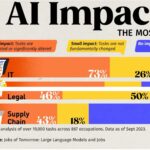AI is the biggest buzzword of the day. To Joël Collin-Demers’ point, if you can substitute the word “computers” or “technology” for AI in a sentence, it’s probably not true AI but instead is a clever use of technology. While technology is still valuable and worthwhile, it’s not Artificial Intelligence. While I was staffing the Synertrade booth at ISM World with their implementation lead Ram Panyam, he had an interesting take on AI, BI, CI and DI as a progression and maturing of AI. The A, B, C, and D stand for Automated, Business, Cognitive, and Default and each represents the next steps for AI in business technology. I will expand upon each of these here and also talk about how and why I use (or actually don’t use) AI in writing these weekly articles. There was an article posted seven (!) years ago about AI, BI, and CI by Dr. Tapati Bandopadhyay (can be found here) that foreshadows these definitions, but a lot changed in seven years.
Automated Intelligence
Artificial Intelligence starts its progression with Automated Intelligence. Much of what has been labeled AI in the last several years falls under this first category. In the supply chain, Automated Intelligence includes things like automatically generating/sending purchase orders, filling out forms, tracking shipments from scan points, etc. We have debatably had this form of AI for many years as technology continuously gets better at minimizing or eliminating tactical tasks. Automated Intelligence is a “quiet” AI in that it’s not super impressive or mind-blowing, but it’s definitely the quickest value for the money. Automated Intelligence is usually faster to add or implement to your supply chain processes and tends to immediately free up resources to do more strategic work.
Business Intelligence
Business Intelligence is where AI is applied to business analytics, measuring metrics, and shifting a business toward a more proactive approach. Business intelligence organizes data and makes it more accessible, creates actionable paths, and tries to predict the future based on current trends. Business Intelligence is good at taking columns of numbers and turning them into something understandable, presentable, and that starts to tell a story (the rest of the story still needs a human touch). Business Intelligence also includes running some “what if” scenarios, which are especially useful in supply chain risk assessments.
Cognitive Intelligence
I think of Cognitive Intelligence as the “current hotness.” By that, I mean that Cognitive Intelligence includes the kinds of AI people are talking about and excited about right now: Large language models (like ChatGPT), image recognition, and visual creation. Cognitive Intelligence gets into the science fiction side of AI – computers who think and blur the lines between human and machine. If AI, BI, CI and DI are a progression, Cognitive Intelligence would have the big “you are here” arrow pointing at it. One of my personal favorite uses of Cognitive Intelligence in the supply chain has been writing better scopes of work. It’s always easier to edit than write from a blank piece of paper, and I’ve seen great success when technical teams start their scopes using a large language model to write the first draft.
One note about using these models: the data put into them is in no way confidential. Unless your company has its own walled-off large language model, treat everything you put into a large language model as public by default. I realize this is more conservative than I need to be, but most of my career was spent in an extremely conservative cybersecurity space and it’s important people are aware of these limitations. Consider just using “Company” instead of your company name to draft the initial scope and be careful of your company’s proprietary information.
Default Intelligence
Default Intelligence is our next step. Interestingly enough, Default Intelligence circles back around to being invisible just like Automated Intelligence. When fully up and running, Default Intelligence is the computer quietly helping us in the background, making suggestions and setting things up the way we like them without us noticing. If technology leaders can get this right, we won’t notice Default Intelligence even exists, only when it’s missing for some reason (such as a less sophisticated program). In the supply chain, this might be autopopulating RFPs with only a few prompts. When it’s really up and running, I think based on only a few inputs such as category and general description it could summon up the right contract template, draft a scope of work from the last time you bid a category, populate the list of suppliers (updating their contact info based on the email you received from the sales rep saying they were your new rep), and write up your go/no-go criteria based on the recently updated procurement policy and expected risk areas. While this feels still just out of reach, I will say that I’m starting to see especially Procure-to-pay platforms get there. Other web-based software is also moving in this direction rapidly, I simply see the most of the procure-to-pay space in my current world.
Organizing the Current AI Space
Joël’s article calls out ten kinds of AI and organizes them nicely:
- Robotic Process Automation (RPA)
- Machine Learning (Processing and Regression)
- Natural Language Processing (NLP)
- Predictive Analytics
- Anomaly Detection
- Computer Vision
- Optimization Algorithms
- Large Language Models (LLMs)
- Recommendation Systems
- Reinforcement Learning
Combining these two frameworks, This is how I see these types organized into AI, BI, CI and DI:
Automated Intelligence:
Robotic Process Automation (#1)
Machine Learning (#2)
Anomaly Detection (#5)
Business Intelligence:
Natural Language Processing (#3)
Predictive Analytics (#4)
Optimization Algorithms (#7)
Cognitive Intelligence:
Computer Vision (#7)
Large Language Models (#8)
Default Intelligence:
Recommendation Systems (#9)
Reinforcement Learning (#10)
The key to being a professional in our AI future is continuing to provide the soft skills computers cannot fully mimic: compassion, empathy, grace, encouragement, creativity, and similar skills. Supply chain team members who are fully transactional and simply input data from one field to another could be replaced by AI. Those who build relationships with their technical teams, listen for true needs instead of wants, creatively solve problems with win-win solutions, and manage change well will be those who succeed best.
AI and These Articles
Now it gets personal. I don’t use large language models to draft or edit these articles each week. I write them and self-edit. There are some drawbacks to that, of course, but I do it for a couple reasons:
- I initially drafted these articles and used AI to edit them, but they sounded like AI. You will probably see and read that in some of my very earliest articles if you go look. Perhaps if I was willing to pay for a large language model subscription they could sound more like me, but I’ve built my business one expense at a time (I don’t even want to tell you how long it took me to switch from Google Sheets to purchasing Excel) and that expense never seemed like one that was worthwhile.
- I’m aware of the energy cost of AI. This one is interesting because I worked in the energy industry, and currently data centers are asking for more capacity than can possibly be built. I think this is a bubble that, when it bursts, will snap back on us all. We will have overbuilt data centers and the average consumer will see the impact on their home electricity bill. At least in the U.S. I’m not sure what other countries will see as utilities are very different all over the world.
- I enjoy writing. I did write a book and am a reasonably fast and accurate writer. I’m always trying to find ways to add value to the supply chain space, and this seems to be one area where I can. These articles are authentically me, and I’m hoping to keep them that way. Even if that means I have to reduce the frequency at some point.
At least for a while, I did use AI to help me write titles for my articles. I’m not terribly good at naming things (my husband helped me name my business) and coming up with compelling titles is still not my strong suit. But I’ve been trying to do so more recently. Similarly, sometimes I use AI to come up with my article graphics. But only if I can’t come up with a way to provide my own. As much as possible, I try to build my own graphics. Perhaps I’m taking the hard road; I’d love feedback if you’ve read this far and feel like offering it.
If you’d like to talk about how AI is impacting you and where you see the future going, let’s chat. If you’d like to get these articles weekly straight to your inbox and never miss one, sign up for my newsletter.
My book, Transform Procurement: The Value of E-auctions is now available in ebook and paperback formats: https://www.amazon.com/dp/B0F79T6F25




